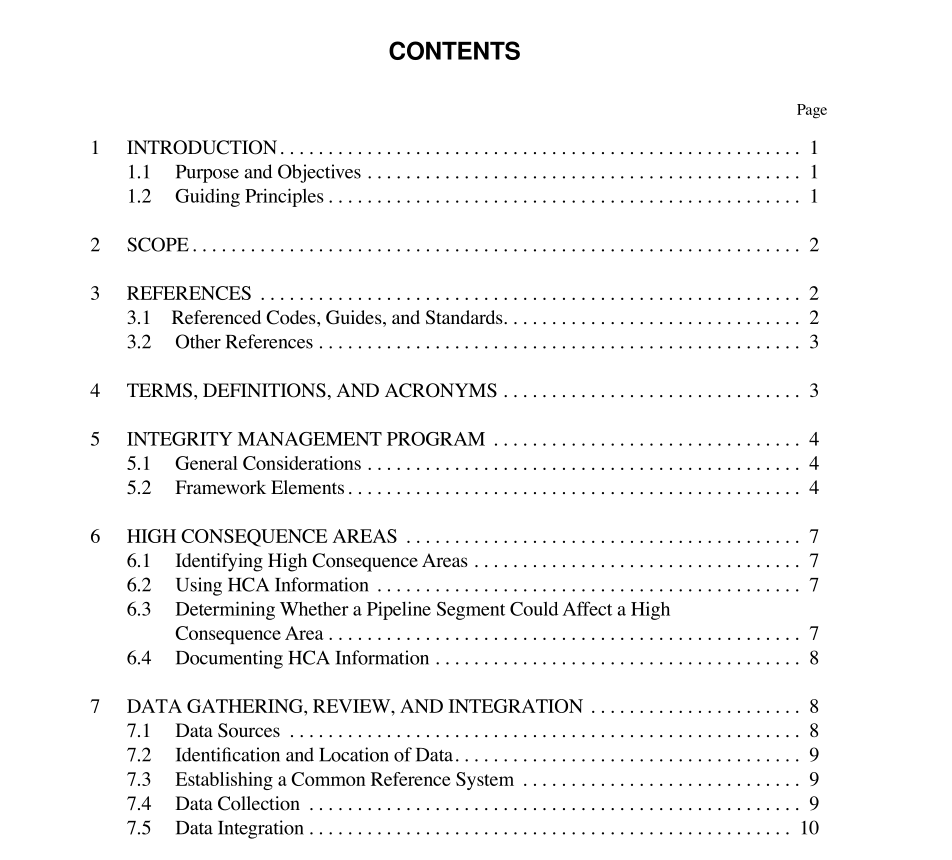API Std 1160 pdf download

API Std 1160 pdf download.Managing System Integrity for Hazardous Liquid Pipelines
1 Introduction
1.1 PURPOSE AND OBJECTIVES
The goal of the operator of any pipeline is to operate the pipeline in such a way that there are no adverse effects on employees, the environment, the public, or their customers as a result of their actions. They do this while they Þll the needs of the customer and earn a reasonable return on their invest- ment. The goal is error-free, spill-free, and incident-free oper- ation of the pipeline. An integrity management program provides a means to improve the safety of pipeline systems and to allocate opera- tor resources effectively to: ¥ Identify and analyze actual and potential precursor events that can result in pipeline incidents. ¥ Examine the likelihood and potential severity of pipe- line incidents. ¥ Provide a comprehensive and integrated means for examining and comparing the spectrum of risks and risk reduction activities available. ¥ Provide a structured, easily communicated means for selecting and implementing risk reduction activities. ¥ Establish and track system performance with the goal of improving that performance. This standard outlines a process that an operator of a pipe- line system can use to assess risks and make decisions about risks in operating a hazardous liquid pipeline in order to reduce both the number of incidents and the adverse effects of errors and incidents. Section 5 describes the integrity man- agement framework that forms the basis of this standard. This framework is illustrated schematically in Figure 5-1. This standard also supports the development of integrity manage- ment programs required under Title 49 CFR 195.452 of the federal pipeline safety regulations. This standard is intended for use by individuals and teams charged with planning, implementing, and improving a pipe- line integrity management program. Typically a team would include engineers, operating personnel, and technicians or specialists with speciÞc experience or expertise (corrosion, in-line inspection, right-of-way patrolling.
1.2 GUIDING PRINCIPLES
In developing this standard on managing pipeline system integrity, certain guiding principles underlie the entire docu- ment. These principles are reßected in many of the sections and are provided here to give the reader the sense of the need to view pipeline integrity from a broad perspective. Integrity must be built into pipeline systems from initial planning, design, and construction. Integrity management of a pipeline starts with the sound design and construction of the pipeline. Guidance for new construction is provided in a number of consensus standards, including ASME B31.4, as well as the pipeline safety regulations. As these standards and guidelines are applied to the design of a pipeline, the designer must consider the area the pipeline traverses and the possible impacts that the pipeline may have on that area and the people that reside in its vicinity. New construction is not a subject of this standard, but the design speciÞcations and as-built condi- tion of the pipeline provide important baseline information for an integrity management program. System integrity is built on qualified people , using defined processes to operate maintained facilities . The integrity of the physical facility is only part of the complete system that allows an operator to reduce both the number of incidents and the adverse effects of errors and incidents. The total system also includes the people that operate the facility and the work processes that the employees use and follow. A comprehen- sive integrity management program should address people, processes, and facilities. An integrity management program must be flexible.









